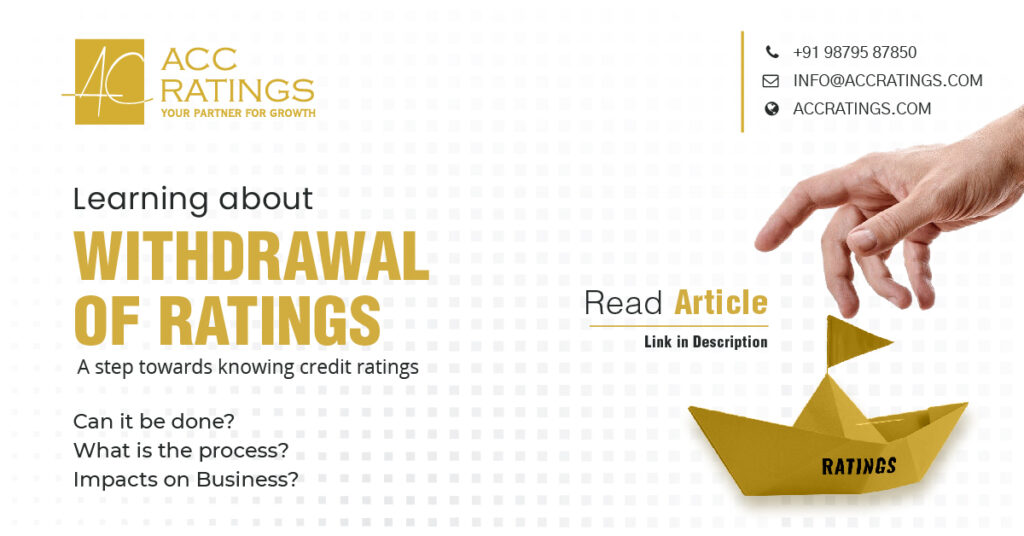Withdrawal of Ratings

Withdrawal of Ratings is when CRA no longer rates an entity, debt, or any other financial instrument to which the CRA assigned specific rating.
This week we will explore about Credit Rating Withdrawal in brief, with an aim to provide outline on when it’s possible in Indian context.
Withdrawal of Ratings
Credit Rating is an instrument of measuring risk factor any business may have. Ratings allow investors evaluate risk factors in rational way in which financial, managerial, industrial, and other type of risks are flatten to the scale of rating. Credit ratings shows investment eligibility to the investors and borrowing eligibility to the business owners.
However, there can be circumstances which may lead change in ratings. These can be done by continuous evaluation by Credit Rating Agencies (CRAs). There is fundamental regulatory requirement for Credit Ratings in case of corporate borrowings from debt instruments. When things change or gets complicated, or ratings are no longer required, withdrawal of ratings can happen. So, let’s dive into specifics and learn about withdrawal of ratings and how CRAs can perform it.
What is withdrawal of ratings?
In simple words, Withdrawal of Ratings is when CRA no longer rates an entity, debt, or any other financial instrument to which the CRA assigned specific rating. Once CRA assigns ratings, they are bound and obliged to rate given debt instrument for security purposes.
CRAs have obligation to continuously monitor and rate the securities until their lifetime. This means withdrawal of ratings cannot happen directly. Withdrawal of Ratings can only happen under certain circumstances. The withdrawal procedure allows CRA to detach from the rating obligation.
Generally, Ratings can be assigned to any financial instrument involved with economics. This makes Credit Ratings a big topic and each financial instrument have their own set of withdrawal criteria. These financial instruments include bank loans, public fund deposits, fixed deposits, and many other sources. However, with the article we would focus on Corporate Credit Rating, which is main Rating tied up to businesses. We have already covered Corporate Credit Ratings Process which explains through workflow of obtaining a credit rating.
There may be many reasons why CRA or an issuer may want to withdraw ratings. So, let’s start with understanding why rating withdrawal is required in the first place?
Reasons why a CRA may withdraw rating
CRA may withdraw a Credit Rating for any of the following reasons:
- Bankruptcy / Liquidation / Debt Restructuring / Write-down of a Structured Finance Security: if a Rated Entity defaults, enters bankruptcy, is liquidated, or restructures its debt, or if a structured finance security experiences a full or partial write-down that results in a zero-current balance, it may no longer be useful or necessary for CRA to maintain a Credit Rating on that Rated Entity or that Rated Entity’s obligation ns.
- Reorganization: if a Rated Entity becomes the subject of a corporate reorganization or regulator-imposed restructuring, including a merger or acquisition, or enters any other form of governmental administration, it may no longer be useful or necessary for CRA to maintain a Credit Rating on that Rated Entity or that Rated Entity’s obligations.
- Methodological thresholds for certain Structured Finance transactions: if the applicable Credit Rating Methodology states that CRA will not maintain Credit Ratings if aspects of the transaction cross specified thresholds, CRA shall withdraw the Credit Rating on order of Regulator.
- In the case of provisional ratings, if the structure adopted for the transaction, deviates significantly from that is considered while assigning the provisional rating, CRA may withdraw the provisional rating.
Regulatory obligation for withdrawal of ratings
Currently, the CRA regulations, do not allow withdrawal of ratings by CRAs and require CRAs to continuously monitor the rating of securities during the lifetime of securities. Only special cases would result into withdrawal of ratings. The withdrawal is also subject to regulatory approval and they can be rejected if they do not meet regulatory compliance.
This mechanism protects the interests of all stake holders. A CRA gets to serve & rate business for longer period and can get accurate ratings. Business can benefit from long term rating process to analyse and streamline their risks. Regulator can be sure that each actor in the process is in role. Investors can be sure that there are regulations protecting them. Such a framework prohibits misleading and unnecessary changes.
However as standard process regulators have listened to all the stakeholders and allowed certain provisions which makes withdrawal of ratings possible.
When CRAs can Withdraw Ratings?
As per SEBI Circular dated March 31, 2017, it was clarified that withdrawal of ratings is permitted for bank loans/ facilities and open-ended mutual fund schemes, subject to certain conditions and disclosure of reason(s) for withdrawal in the Press Release.Issuer may request withdrawal when they wish to avail other CRA. CRA maybe allowed to withdraw the ratings subject to the CRA having rated that instrument continuously for 5 years or 50% of tenure of instrument, whichever is higher.
SEBI has also relaxed the norms for CRAs to withdraw from an issue, which has multiple ratings. This allows single rating per instrument since multiple ratings would result in additional resources without productive outcome. Additionally, the CRA must have received a no-objection certificate from 75 percent of the bond holders of the outstanding debt for withdrawal of rating. The CRA must also have received an undertaking from the issuer that another rating is available on that instrument.
As per INC (Issuer Not Cooperating) Ratings circular dated on 3rd January 2020 by SEBI, the rating agency can withdraw ratings if it has rated an instrument for three years continuously or for 50 per cent of the tenure of the instrument, whichever is longer. This applies once ratings are downgraded to non-investment grade for more than 6 months and then to INC status if non-cooperation remains.
At the time of withdrawal, the CRA should assign a rating to such instrument and issue a press release in the prescribed format mentioning the reason for withdrawal of rating.
What does it mean for business?
CRAs can withdraw rating under specific circumstances. Since credit rating process is long term, resource intensive and continuous process, the complications arise from changing CRAs are not in favour of any stake holder. Regulators have come up with process where CRAs and businesses can mutually depart. Rating process is all about trust and in general cases withdrawal of ratings is rarely required.
CRAs may only invoke withdrawal if they meet the conditions listed above, otherwise both CRA and issuer are bound by rating agreement and regulations which are mended on time to time by SEBI.
It is also noteworthy that withdrawal of ratings by a CRA would not result in the listed security becoming unrated, as SEBI (Listing Obligations and Disclosure Requirements) Regulations, 2015 mandate that NCDs need to be rated and reviewed periodically by CRAs.
CRAs have their own policies when businesses wish to Rate themselves. Withdrawal policy is the part of Credit Rating agreement in compliance with regulator. These policies are public and can be found on CRA websites. Regulators mandate these policies from time-to-time in order to make economic operations more transparent and trustworthy.
Keep reading:








